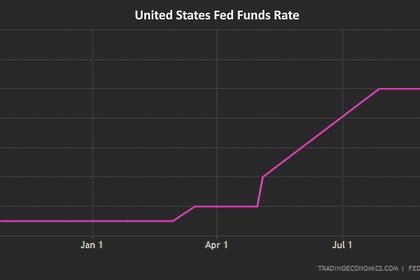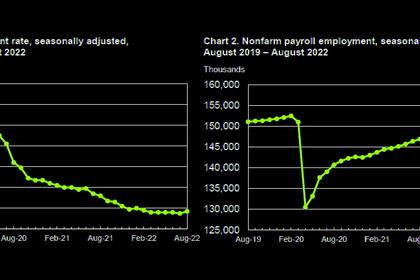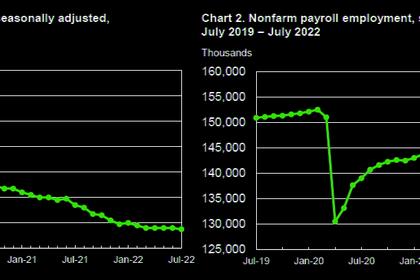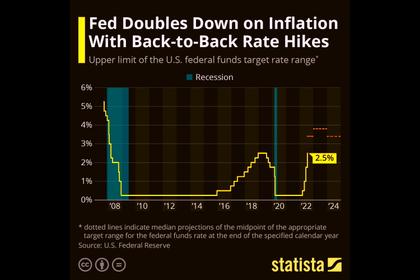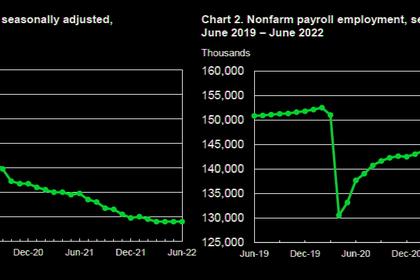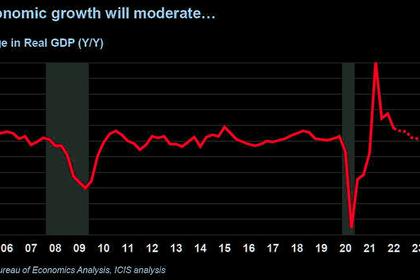
U.S. EMPLOYMENT UP BY 263,000
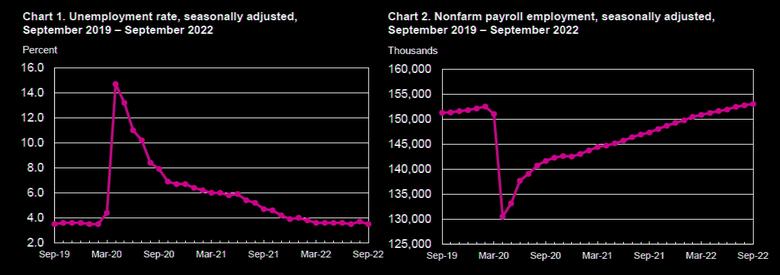
U.S. BLS - October 7, 2022 - THE EMPLOYMENT SITUATION—SEPTEMBER 2022
Total nonfarm payroll employment increased by 263,000 in September, and the unemployment rate edged down to 3.5 percent, the U.S. Bureau of Labor Statistics reported today. Notable job gains occurred in leisure and hospitality and in health care.
This news release presents statistics from two monthly surveys. The household survey measures labor force status, including unemployment, by demographic characteristics. The establishment survey measures nonfarm employment, hours, and earnings by industry. For more information about the concepts and statistical methodology used in these two surveys, see the Technical Note.
Household Survey Data
The unemployment rate edged down to 3.5 percent in September, returning to its July level. The number of unemployed persons edged down to 5.8 million in September. (See table A-1.)
Among the major worker groups, the unemployment rate for Hispanics decreased to 3.8 percent in September. The jobless rates for adult men (3.3 percent), adult women (3.1 percent), teenagers (11.4 percent), Whites (3.1 percent), Blacks (5.8 percent), and Asians (2.5 percent) showed little change over the month. (See tables A-1, A-2, and A-3.)
Among the unemployed, the number of permanent job losers decreased by 173,000 to 1.2 million in September. The number of persons on temporary layoff changed little at 758,000. (See table A-11.)
The number of long-term unemployed (those jobless for 27 weeks or more) was little changed at 1.1 million in September. The long-term unemployed accounted for 18.5 percent of all unemployed persons. (See table A-12.)
The labor force participation rate was little changed at 62.3 percent in September, and the employment-population ratio was unchanged at 60.1 percent. Both measures are 1.1 percentage points below their values in February 2020, prior to the coronavirus (COVID-19) pandemic. (See table A-1.)
The number of persons employed part time for economic reasons decreased by 306,000 to 3.8 million in September. These individuals, who would have preferred full-time employment, were working part time because their hours had been reduced or they were unable to find full-time jobs. (See table A-8.)
The number of persons not in the labor force who currently want a job was little changed at 5.8 million in September and remains above its February 2020 level of 5.0 million. These individuals were not counted as unemployed because they were not actively looking for work during the 4 weeks preceding the survey or were unavailable to take a job. (See table A-1.)
Among those not in the labor force who wanted a job, the number of persons marginally attached to the labor force was little changed in September at 1.6 million. These individuals wanted and were available for work and had looked for a job sometime in the prior 12 months but had not looked for work in the 4 weeks preceding the survey. The number of discouraged workers, a subset of the marginally attached who believed that no jobs were available for them, increased by 119,000 to 485,000 in September. (See Summary table A.)
Household Survey Supplemental Data
In September, 5.2 percent of employed persons teleworked because of the coronavirus pandemic, down from 6.5 percent in the prior month. In May 2020, the first month these data were collected, 35.4 percent of employed persons teleworked because of the coronavirus pandemic. These data refer to employed persons who teleworked or worked at home for pay at some point in the 4 weeks preceding the survey specifically because of the pandemic.
In September, 1.4 million persons reported they had been unable to work because their employer closed or lost business due to the pandemic—that is, they did not work at all or worked fewer hours at some point in the 4 weeks preceding the survey due to the pandemic. This measure is down from 1.9 million in the previous month and from 49.8 million in May 2020. Among those who reported in September that they were unable to work because of pandemic-related closures or lost business, 21.4 percent received at least some pay from their employer for the hours not worked, essentially the same as in August.
Among those not in the labor force in September, 452,000 persons were prevented from looking for work due to the pandemic, little changed from the prior month. In May 2020, 9.7 million persons were prevented from looking for work due to the pandemic. (To be counted as unemployed, by definition, individuals must be either actively looking for work or on temporary layoff.)
These supplemental data come from questions added to the household survey from May 2020 through September 2022 to help gauge the effects of the pandemic on the labor market. The data are not seasonally adjusted. Tables with estimates from the supplemental questions for all months are available online at www.bls.gov/cps/effects-of-the-coronavirus-covid-19-pandemic.htm. For information about the new supplemental questions being introduced in October 2022, see the box note on page 5.
Establishment Survey Data
Total nonfarm payroll employment increased by 263,000 in September. Monthly job growth has averaged 420,000 thus far in 2022, compared with 562,000 per month in 2021. In September, notable job gains occurred in leisure and hospitality and in health care. (See table B-1.)
Leisure and hospitality added 83,000 jobs in September, in line with the average monthly job gain over the first 8 months of the year. Within the industry, employment in food services and drinking places rose by 60,000 in September. Employment in leisure and hospitality is below its pre-pandemic February 2020 level by 1.1 million, or 6.7 percent.
In September, employment in health care rose by 60,000 and has returned to its February 2020 level. Over the month, ambulatory health care services and hospitals each added 28,000 jobs. Employment in professional and business services continued its upward trend in September (+46,000).
Thus far in 2022, job growth in the industry has averaged 72,000 per month. Employment in temporary help services continued to trend up (+27,000) in September. Job gains occurred in investigation and security services (+9,000) and in scientific research and development services (+5,000). Job losses occurred in business support services (-12,000), legal services (-5,000), and advertising and related services (-5,000).
Manufacturing employment continued to trend up in September (+22,000). Job gains occurred in motor vehicles and parts (+8,000), fabricated metal products (+6,000), and electrical equipment and appliances (+3,000). Printing and related support activities lost 4,000 jobs over the month. Manufacturing has added an average of 36,000 jobs per month thus far in 2022.
In September, employment in construction continued to trend up (+19,000), in line with average monthly job growth in the first 8 months of this year. Specialty trade contractors added 18,000 jobs in September.
Employment in wholesale trade continued its upward trend in September (+11,000). Wholesale trade has added an average of 18,000 jobs per month thus far in 2022. In September, employment in financial activities changed little (-8,000), as declines in insurance carriers and related activities (-9,000) and nondepository credit intermediation (-7,000) were partially offset by a job gain in depository credit intermediation (+5,000).
Employment in transportation and warehousing was little changed in September (-8,000). A loss of 11,000 jobs in truck transportation was partially offset by a gain of 3,000 jobs in air transportation. Employment showed little change over the month in other major industries, including mining, retail trade, information, other services, and government.
In September, average hourly earnings for all employees on private nonfarm payrolls rose by 10 cents, or 0.3 percent, to $32.46. Over the past 12 months, average hourly earnings have increased by 5.0 percent. In September, average hourly earnings of private-sector production and nonsupervisory employees rose by 10 cents, or 0.4 percent, to $27.77. (See tables B-3 and B-8.)
In September, the average workweek for all employees on private nonfarm payrolls was 34.5 hours for the fourth month in a row. In manufacturing, the average workweek for all employees was unchanged at 40.3 hours, and overtime held at 3.2 hours. The average workweek for production and nonsupervisory employees on private nonfarm payrolls increased by 0.1 hour to 34.0 hours. (See tables B-2 and B-7.)
The change in total nonfarm payroll employment for July was revised up by 11,000, from +526,000 to +537,000, and the change for August remained at +315,000. After revision, employment gains in July and August combined were 11,000 higher than previously reported. (Monthly revisions result from additional reports received from businesses and government agencies since the last published estimates and from the recalculation of seasonal factors.)
-----
Earlier:
